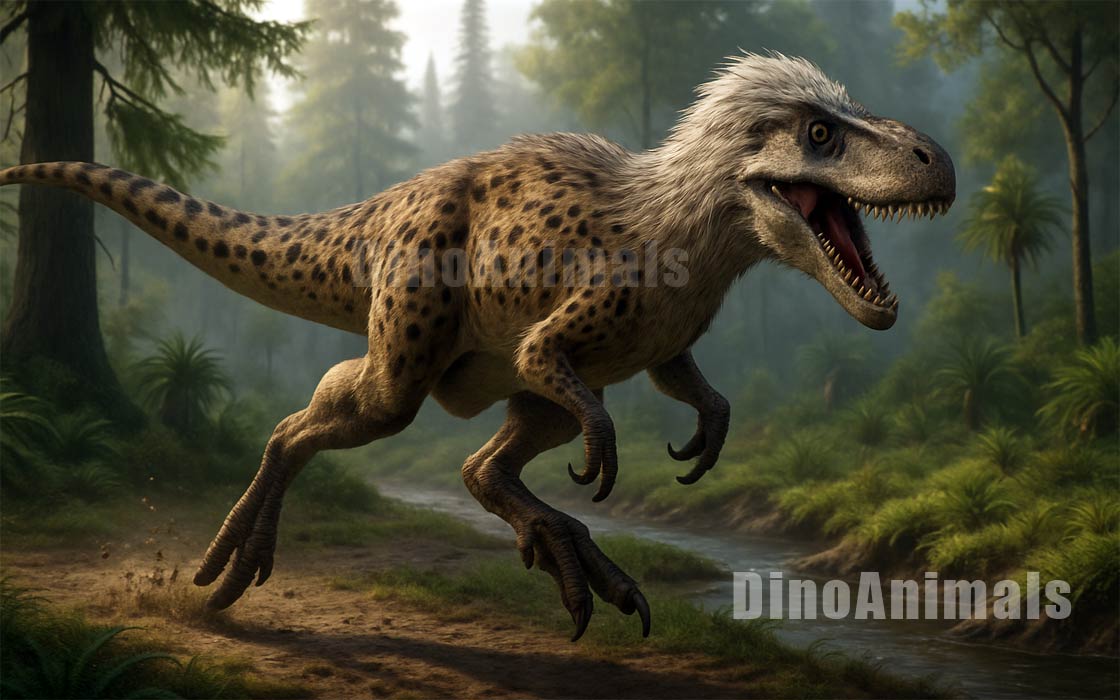Every month, 100,000 readers use the Dinosaur Database, but we receive no support from you. Developing and updating the database requires a lot of work. If you want it to remain open and be updated, please support us via the "Buy us a coffee" button available on every page or via the Support page.
Dinosaur: Nanotyrannus lancensis

| Length*: | 6.35 m | 20.8 ft |
| Weight*: | 660 kg | 1,455 lb |
*The largest known specimen
Period
Epoch: Late Cretaceous
Stage: Late Maastrichtian
Years: 68–66 Ma
Details
Status: valid
Author: Bakker, Williams & Currie
Year: 1988
Distribution
Area: North America
Country: USA
Region: Montana, South Dakota, Wyoming
Formation: Hell Creek, Lance
Description
Nanotyrannus lancensis
The Controversial “Dwarf Tyrant” of the Late Cretaceous
Nanotyrannus lancensis is a highly debated species of theropod dinosaur from the Late Cretaceous period, around 68–66 million years ago. Discovered in the Hell Creek Formation of Montana, USA, it has been a subject of controversy due to its classification. Initially described as a small, distinct species of tyrannosaurid, it is now largely considered by many paleontologists to represent juvenile individuals of Tyrannosaurus rex. The name Nanotyrannus means “dwarf tyrant,” highlighting its smaller size compared to other tyrannosaurids, while lancensis refers to the Lance Formation, where early remains were first found.
Physical Characteristics
The holotype specimen of Nanotyrannus lancensis, CMNH 7541, includes a nearly complete skull approximately 60 cm (2.0 ft) long. Initial research, led by Robert T. Bakker and colleagues in 1988, noted that the skull bones appeared fused, leading to the conclusion that it represented an adult dinosaur of a small size, with a total body length estimated at around 5.2 meters (17 feet).
The skull is slender and shallow, featuring a high tooth count, which some researchers, like Peter Larson, argue is evidence of its distinction from T. rex. Additionally, Nanotyrannus exhibits proportionally larger hands and longer legs, suggesting a more cursorial (adapted for running) lifestyle than adult T. rex. However, more recent studies by Thomas Carr (1999, 2020) and others indicate that the “fused” bones were misinterpreted and are instead consistent with juvenile growth stages in T. rex. Carr’s detailed analysis of Nanotyrannus material suggests that the skull represents a juvenile T. rex under 13 years of age, with all the growth characteristics expected for this ontogenetic stage.
Diet and Feeding Habits
As a member of the Tyrannosauroidea clade, Nanotyrannus lancensis (whether a distinct species or juvenile T. rex) was a carnivorous predator. The slender build of the skull and jaws indicates a high degree of bite agility, potentially allowing it to target smaller prey compared to the larger adult T. rex. If it is indeed a juvenile T. rex, the dietary habits would have changed over time, with juveniles likely focusing on faster, smaller prey and later transitioning to larger prey as they matured and grew into powerful apex predators.
Habitat and Distribution
Nanotyrannus lancensis lived in the region now known as the Hell Creek Formation, which covered parts of modern-day Montana, South Dakota, and Wyoming during the Late Cretaceous. The Hell Creek Formation was a lush, subtropical environment with forests, rivers, and wetlands, supporting a diverse array of dinosaur species, including ceratopsians, hadrosaurs, and ankylosaurs, which would have provided ample prey for tyrannosaurs.
Other T. rex fossils are also found in this formation, leading many paleontologists to argue that the Nanotyrannus specimens represent juvenile stages of T. rex, rather than a distinct species coexisting with larger adult tyrannosaurs.
Behavior and Social Structure
If Nanotyrannus represents juvenile T. rex, its behavior would have been similar to that of growing theropods. Juveniles likely had different hunting strategies and dietary preferences from adults, focusing on smaller and faster prey while relying on agility rather than brute strength. This would have minimized competition between younger individuals and larger adults within the same environment.
Research on T. rex suggests that these theropods may have exhibited some social behavior, potentially living in loosely organized family groups or hunting cooperatively. If Nanotyrannus is a separate species, its slender build and proportionately larger hands and legs suggest it may have relied more on speed and dexterity compared to larger tyrannosaurs, but the evidence for such social structures is not well-preserved.
Discovery and Research
The original Nanotyrannus lancensis holotype, CMNH 7541, was discovered in the 1940s and was initially classified as Gorgosaurus lancensis. However, in 1988, it was reexamined by Robert Bakker, Phil Currie, and Michael Williams, who proposed that it represented a new genus and species, Nanotyrannus lancensis. Their research suggested that the specimen was a small adult based on the fused skull bones.
In the following decades, Nanotyrannus was revisited in numerous studies. A more complete specimen, known as “Jane” (BMRP 2002.4.1), was discovered in 2001, prompting further debate. While some, including Peter Larson, continued to argue that Nanotyrannus represented a distinct species, most paleontologists, including Thomas Carr, have concluded that it represents a juvenile T. rex, as Carr’s 2020 study found that juvenile T. rex specimens, including CMNH 7541 and “Jane,” formed a continuous growth series with subadult T. rex fossils.
However, a 2024 paper by Nick Longrich and Evan Thomas Saitta reexamined the evidence and suggested that Nanotyrannus might indeed represent a distinct taxon, citing differences in skull morphology and limb proportions that could distinguish it from T. rex. They also raised the possibility that Nanotyrannus falls outside Tyrannosauridae, based on certain phylogenetic analyses.
Significance and Interesting Facts
Nanotyrannus lancensis is one of the most controversial theropod dinosaurs, with paleontologists divided over whether it represents a distinct species or simply juvenile Tyrannosaurus rex. If Nanotyrannus is indeed a separate species, it would have coexisted with T. rex in the same environment, representing an example of niche partitioning among top predators. Alternatively, if it is simply a juvenile T. rex, it provides valuable insights into the growth and development of one of the most iconic dinosaurs.
One interesting fact about Nanotyrannus is that its smaller size, greater agility, and larger hand proportions have made it an appealing figure in popular media, despite the ongoing scientific debate over its status.

Description Supplement: Recent Advances in Understanding Nanotyrannus lancensis
Recent research published in 2025 by paleontologists Lindsay E. Zanno and James G. Napoli has significantly reshaped our understanding of Nanotyrannus lancensis, confirming it as a valid, distinct taxon rather than an immature stage of Tyrannosaurus rex. This study, based on an exceptionally preserved specimen (NCSM 40000) from the Hell Creek Formation in Montana, USA, along with comparative analyses of other fossils, provides compelling evidence from comparative anatomy, bone histology, growth modeling, and phylogeny. The findings not only validate Nanotyrannus as a separate genus but also identify two species within it: N. lancensis (including the holotype CMNH 7541 and NCSM 40000) and a new species, N. lethaeus (based on the “Jane” specimen, BMRP 2002.4.1). This supplement draws on these insights to expand the description of N. lancensis, highlighting its unique features, growth patterns, ecological role, and distinctions from Tyrannosaurus rex.
Taxonomic History and Validation
Nanotyrannus lancensis was first described in 1946 by Charles W. Gilmore as Gorgosaurus lancensis, based on a small skull (CMNH 7541) from the Hell Creek Formation. It was later reassigned to Nanotyrannus in 1988 by Robert T. Bakker, Michael Williams, and Philip J. Currie, who argued it represented a small tyrannosauroid. However, for decades, many paleontologists dismissed it as a juvenile Tyrannosaurus rex, citing similarities in skull shape and the assumption that its slender features were ontogenetic (growth-related) traits that would change with maturity.
The 2025 study overturns this view through multiple lines of evidence. The authors examined NCSM 40000, a nearly complete skeleton of N. lancensis recovered near Jordan, Montana, dated to approximately 66.9 million years ago (within the upper lower to lower upper Hell Creek Formation). This specimen shares unique features (autapomorphies) with the holotype CMNH 7541, such as a short maxillary fenestra and a discrete pneumatic sinus in the palatine bone. Phylogenetic analysis places Nanotyrannus in a new family, Nanotyrannidae, as an early diverging member of Eutyrannosauria – outside the more derived Tyrannosauridae family that includes Tyrannosaurus and Albertosaurus. This positioning indicates Nanotyrannus retained more primitive traits from mid-Cretaceous tyrannosauroids.
Importantly, the study demonstrates that traits previously attributed to immaturity in Nanotyrannus – like a slender skull and long arms – are invariant across growth stages and distinguish it from Tyrannosaurus. Over 200 tyrannosaur fossils were reviewed, revealing no transitional forms between small “Nanotyrannus-like” specimens and adult T. rex. This confirms Nanotyrannus coexisted with T. rex as a separate genus, thriving in the Maastrichtian stage of North America just before the end-Cretaceous mass extinction.
Physical Appearance and Anatomy
Nanotyrannus lancensis was a mid-sized theropod dinosaur, characterized by a sleek, agile build adapted for speed and maneuverability, in contrast to the robust, heavy-set Tyrannosaurus rex. The genus diagnosis includes several unique features observable in near-mature individuals:
- Skull and Dentition: The skull is narrower and more elongated than in T. rex, lacking a clear embayment for the subnarial foramen at the premaxilla-maxilla suture. Premaxillary teeth are unserrated, straight, and chisel-shaped. N. lancensis specifically has a short maxillary fenestra and reduced mesialmost dentary teeth (the two frontmost lower jaw teeth are smaller). It possesses around 25 teeth in the lower jaw, compared to only 13 in adult T. rex. The braincase shows a strongly rostroventrally oriented head posture, a laterally oriented vagus canal, and broad communication between pneumatic recesses – features not seen in Tyrannosaurus.
- Axial Skeleton: The vertebral column features two or more pleurocoels (pneumatic openings) on the axis centrum within a fossa, and poorly crenulated neural spines on the axis. Proximal caudal vertebrae have infraprezygapophyseal pneumatic recesses. Neurocentral sutures in NCSM 40000 are mostly closed in the presacral and sacral regions, indicating maturity.
- Forelimbs and Pectoral Girdle: One of the most striking differences is the proportionally larger forelimbs. The humerus is flattened at the head with a medially offset apex, a bulbous supraradiocondylar ridge, and a hypertrophied radial condyle. The manual phalanx PI-1 exceeds 20% of femoral length (much longer than in T. rex), with specialized flexor and extensor pits. The scapula’s glenoid fossa has a tongue-like extension. Overall, the arms are longer and more functional, suggesting Nanotyrannus could use them for grasping or manipulating prey, unlike the vestigial arms of T. rex.
- Hindlimbs and Pelvic Girdle: The hindlimbs are proportionally longer and slimmer, enhancing agility. Metatarsal III (MTIII) has an asymmetrical extensor fossa with a gently convex distal margin, and the medial distal condyle does not project cranially beyond the shaft. The pubic boot has straight margins and is craniomedially projecting in N. lancensis. These traits indicate a build suited for quick pursuits rather than the powerful, bone-crushing ambushes of T. rex.
- Other Diagnostic Traits: Additional features include a pneumatic foramen in the quadratojugal, an acuminate juncture of its rami, a squamosal-quadratojugal fenestra, a pronounced lip on the lacrimal’s pneumatic pocket, and a single dorsal quadrate condyle. N. lancensis differs from N. lethaeus in having a rostral palatine recess forming a discrete sinus (vs. an open fossa), reduced second mesial dentary tooth, and a straight pubic boot margin (vs. dorsally convex).
The overall anatomy paints Nanotyrannus lancensis as a lithe predator, perhaps 5-6 meters (16-20 feet) long and 1.5-2 meters (5-6.5 feet) tall at the hip, with a narrower snout, sharper senses, and greater dexterity.
Size, Growth, and Maturity
Bone histology from NCSM 40000 reveals 25 cyclical growth marks (CGMs) in the femur and 15 in the tibia, indicating at least 14 years of growth. The outer bone shows an external fundamental system (EFS) – tightly packed growth lines signaling slowed growth – confirming the animal was near skeletal maturity at death, with an estimated mass of 704 kg (1,552 lbs). Growth models predict an asymptotic (adult) mass of around 700 kg (1,543 lbs) for N. lancensis, over an order of magnitude smaller than T. rex (6,753-8,223 kg or 14,890-18,128 lbs).
In contrast, N. lethaeus (BMRP 2002.4.1) was immature at death (819 kg or 1,807 lbs) but projected to reach 1,264 kg (2,787 lbs). Modeling all Nanotyrannus specimens as Tyrannosaurus juveniles results in an implausible bimodal growth curve, with a prolonged plateau followed by explosive growth – not seen in any archosaur. This supports Nanotyrannus as a distinct taxon with a slower, steadier growth trajectory, reaching maturity in 15-20 years like other non-tyrannosaurine tyrannosaurids.
Differences from Tyrannosaurus rex
Nanotyrannus lancensis shares some superficial similarities with juvenile T. rex (e.g., large eyes, slender proportions), but dozens of invariant traits differentiate them:
- Smaller adult size and more gracile skeleton.
- More teeth and different tooth morphology (unserrated premaxillary teeth vs. serrated in T. rex).
- Absence of a postorbital cornual process and other robust skull reinforcements.
- Larger, more robust forelimbs (over twice the proportional size).
- Different braincase pneumatics and head orientation.
- No evidence of ontogenetic transformation into T. rex-like features; mature Nanotyrannus retain “juvenile-like” traits.
These differences indicate ecomorphological distinction: Nanotyrannus was a fast, agile hunter preying on smaller, quicker animals, while T. rex was an apex predator focused on large herbivores.
Paleoecology and Implications
Nanotyrannus lancensis inhabited the floodplains and river systems of the Hell Creek Formation in what is now Montana and surrounding states, coexisting with Tyrannosaurus rex, Triceratops horridus, Edmontosaurus annectens, and other late Maastrichtian fauna. Its presence suggests higher tyrannosauroid diversity than previously thought, with at least two genera occupying different niches just 1 million years before the asteroid impact that ended the Cretaceous.
This revelation prompts reevaluation of prior studies on T. rex ontogeny, niche partitioning, and biomechanics, as many assumed small specimens were young T. rex. Future work may identify true juvenile T. rex fossils, further clarifying end-Cretaceous ecosystems.
For more details, refer to the original paper (Zanno & Napoli, 2025) and ongoing monographic studies on specimens like BMRP 2002.4.1.
Locations
Sources
Material: CMNH 7541 (holotype of Nanotyrannus lancensis; nearly complete articulated skull from the Hell Creek Formation near Jordan, Montana, USA; originally described as Gorgosaurus lancensis in 1946)
NCSM 40000 (referred to N. lancensis; exceptionally well-preserved, articulated near-complete skeleton including skull, full axial column, pectoral and pelvic girdles, forelimbs, and hindlimbs; recovered near Jordan, Garfield County, Montana, USA; upper lower/lower upper Hell Creek Formation, Bayesian modeled age 66.897 ± 0.023/0.028 Ma)
KUVP 156375 (referred to N. lancensis; partial disarticulated skull with associated postcranial elements; Hell Creek Formation, stratigraphic position unresolved)
BMRP 2002.4.1 (“Jane”; holotype of Nanotyrannus lethaeus sp. nov.; well-preserved specimen comprising nearly complete skull, incomplete axial column, pectoral girdle, left humerus, pelvic girdle, and nearly complete hindlimbs; Hell Creek Formation, Carter County, Montana, USA; middle/upper Hell Creek horizon uncertain)
BMRP 2006.4.4 (referred to Nanotyrannus sp. indet.; portions of axial column, pectoral and pelvic girdles, forelimb, and hindlimb; used in growth modeling and osteohistology).
References: Woodward (2020). Growing up Tyrannosaurus rex: Osteohistology refutes the pygmy “Nanotyrannus” and supports ontogenetic niche partitioning in juvenile Tyrannosaurus.
Zanno, Lindsay E.; Napoli, James G. (2025-10-30). "Nanotyrannus and Tyrannosaurus coexisted at the close of the Cretaceous"




